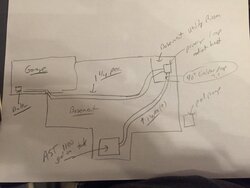After 6+ years of heating with my 150K Econoburn I'm finally getting storage bank
 ! Can't wait till its all hooked and running.......been wanting this for LOOOOOOOONG TIME
! Can't wait till its all hooked and running.......been wanting this for LOOOOOOOONG TIME
I've been through lots of options on how to do it. I've settled on ordering 1100 gallon unpressurized 88"x88", 54" tall from americansolartechnics.com known on here as tom from Maine...
I'm putting it in my finished basement in a room that kicks out 12x16.
I'm just planning on running 1 1/4 pex from my heat bank to primary loop in utility room. I have radiant heat. I'm thinking of putting one circulator that will run automatically at 90 degrees or more. having two shut offs one for supply and one return by primary loop.
wondering how I get temp readings easily so I know what heat storage is an when I need another fire...
also any ideas how to tie into heat for pool as well.
tom helping get this all straight too but will take any ideas so I don't miss any thing...
thanks...

 ! Can't wait till its all hooked and running.......been wanting this for LOOOOOOOONG TIME
! Can't wait till its all hooked and running.......been wanting this for LOOOOOOOONG TIME
I've been through lots of options on how to do it. I've settled on ordering 1100 gallon unpressurized 88"x88", 54" tall from americansolartechnics.com known on here as tom from Maine...
I'm putting it in my finished basement in a room that kicks out 12x16.
I'm just planning on running 1 1/4 pex from my heat bank to primary loop in utility room. I have radiant heat. I'm thinking of putting one circulator that will run automatically at 90 degrees or more. having two shut offs one for supply and one return by primary loop.
wondering how I get temp readings easily so I know what heat storage is an when I need another fire...
also any ideas how to tie into heat for pool as well.
tom helping get this all straight too but will take any ideas so I don't miss any thing...
thanks...


